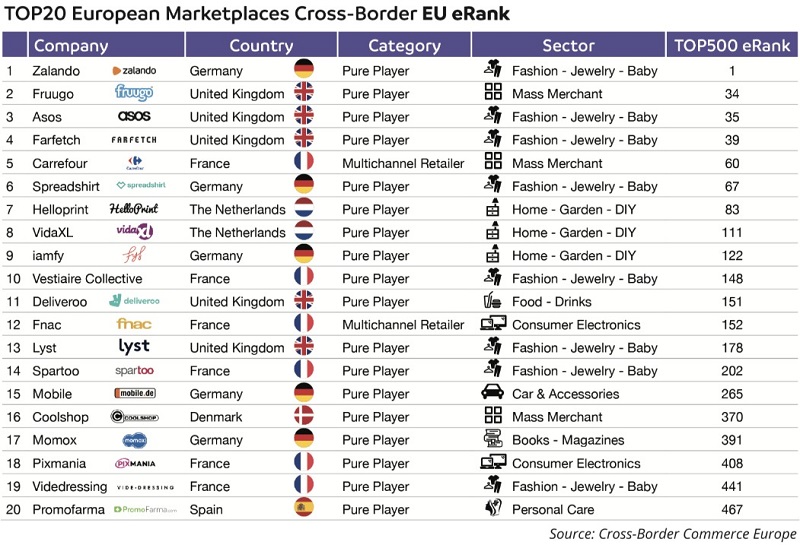Δύο νέες παράλληλες συνεδριακές εκδηλώσεις ανακοινώθηκε πως θα πραγματοποιηθούν στο πλαίσιο της eCommerce & Digital Marketing Expo, στο Ζάππειο Μέγαρο στις 23 & 24 Νοεμβρίου 2019.
Πρόκειται για παράλληλα συνέδρια που αφορούν στον τουρισμό και το celebrities marketing, τα οποία απευθύνονται σε εξειδικευμένα κοινά και λειτουργούν επιπρόσθετα στην προσέλκυση ποιοτικού κοινού, από κλάδους που ενδιαφέρουν τους εκθέτες-χορηγούς της διοργάνωσης.
Το Tourism.Next, είναι ένα συνέδριο για τον τουρισμό και θα πραγματοποιηθεί την Κυριακή 24 Νοεμβρίου, με στόχο να αναδείξει τις βέλτιστες πρακτικές που πρέπει να χρησιμοποιούν οι τουριστικές επιχειρήσεις, για να οδηγήσουν το κοινό απευθείας στις ιστοσελίδες όπου πωλούν τις υπηρεσίες τους, καθώς και η αποτελεσματική παρουσία τους σε πλατφόρμες αναζήτησης.
Καλεσμένοι, θα είναι κορυφαία στελέχη τουριστικών επιχειρήσεων, καθώς και επαγγελματίες του ψηφιακού μάρκετινγκ, οι οποίοι θα μοιραστούν με τους παραβρισκόμενους τους πιο αποδοτικούς τρόπους για να αποκτήσει κάθε επιχείρηση πιστό κοινό και θετική φήμη, να διαφοροποιηθεί από τον ανταγωνισμό και να αναπτυχθεί.
Το δεύτερο παράλληλο συνέδριο, Celebrities in eCommerce, θα διοργανωθεί επίσης την Κυριακή 24 Νοεμβρίου και εστιάζει στις πρακτικές που ακολουθούν αναγνωρίσιμα πρόσωπα από διάφορους κλάδους του καλλιτεχνικού και άλλων χώρων, στην προώθηση υπηρεσιών και προϊόντων και στη συμβολή που έχουν οι συνεργάτες τους στα success stories.
Καλεσμένοι, θα είναι celebrities από επιχειρηματικούς και καλλιτεχνικούς χώρους και συνεργάτες τους, επαγγελματίες στο χώρο του μάρκετινγκ και του Ηλεκτρονικού Επιχειρείν, οι οποίοι θα μοιραστούν με τους παραβρισκόμενους τις εμπειρίες τους από τα project στα οποία έχουν συμμετάσχει.
ECDM Expo 2019
Χώρος διεξαγωγής: Ζάππειο Μέγαρο.
Χρόνος διεξαγωγής: 23 και 24 Νοεμβρίου 2019.
Περισσότερες πληροφορίες:
www.ecdmexpo.com
[social_share googleplus="no" linkedin="yes" whatsapp="no" viber="no"]
Το θέμα της επιβολής ενός ενιαίου φόρου επί των κερδών, που παράγει η ψηφιακή οικονομία, θέτει εκ νέου στην ατζέντα της η Ευρωπαϊκή Ένωση. Μετά από την ατελέσφορη προσπάθεια των κρατών-μελών να καταλήξουν σε συμφωνία για την επιβολή ενός ενιαίου πανευρωπαϊκού ψηφιακού φόρου, το θέμα είχε παραπεμφθεί στη διεθνή κοινότητα και στις ενέργειες για λήψη μιας κοινής απόφασης όλων των χωρών σε παγκόσμιο επίπεδο.
Ωστόσο, όπως προκύπτει από τις γραπτές απαντήσεις των ορισθέντων νέων Επιτρόπων, κατά την ακρόασή τους πριν από την επίσημη ανάθεση των νέων χαρτοφυλακίων, η Ε.Ε. εξετάζει το ενδεχόμενο να ανοίξει εκ νέου το θέμα σε ευρωπαϊκό επίπεδο, αν δεν ευδοκιμήσει η προσπάθεια για διεθνή λύση.
“Οι επόμενοι μήνες θα είναι καθοριστικοί για την επίτευξη προόδου. Εάν δεν μπορέσει να επιτευχθεί συμφωνία έως τα τέλη του 2020, η Ε.Ε. θα πρέπει να είναι διατεθειμένη να ενεργήσει μόνη της. Θα χρειαστούμε μια λύση σε επίπεδο Ε.Ε., η οποία θα ανταποκρίνεται στις προκλήσεις της ψηφιακής οικονομίας, θα αποφέρει οφέλη για την Ε.Ε. και θα μας επιτρέψει να καταλήξουμε σε συμφωνία μεταξύ των κρατών μελών”, τόνισε κυρία Margrethe Vestager κατά τη διαδικασία του κοινοβουλευτικού ελέγχου.
“Πρέπει να διαμορφώσουμε την ψηφιοποίηση, με τρόπο που να ανταποκρίνεται στις ανάγκες της ευρωπαϊκής οικονομίας και της κοινωνίας. Ένα σημαντικό στοιχείο, εν προκειμένω, είναι ότι όλες οι εταιρείες, μεγάλες ή μικρές, παραδοσιακές ή ψηφιακές, οφείλουν να καταβάλλουν τον φόρο που τους αναλογεί. Για το σκοπό αυτό, χρειαζόμαστε ένα δίκαιο διεθνές φορολογικό δίκαιο”, τόνισε η κυρία Vestager, σημειώνοντας ότι το υφιστάμενο πλαίσιο για την εταιρική φορολόγηση είναι υπερβολικά περίπλοκο και δεν διασφαλίζει την φορολόγηση των κερδών εκεί όπου παράγονται.
Δείτε περισσότερα στο sepe.gr.
[social_share googleplus="no" linkedin="yes" whatsapp="no" viber="no"]
Η έκθεση eCommerce & Digital Marketing Expo και ο GR.EC.A, συνεργάζονται για να παρουσιάσουν στο σύνολο του κλάδου του Ηλεκτρονικού Εμπορίου όλες τις εξελίξεις που θα συμβάλλουν στην περαιτέρω ανάπτυξή του.
Η ECDM Expo είναι η μόνη διοργάνωση στην Ελλάδα που απευθύνεται στους επιχειρηματίες από όλη τη χώρα αλλά και την ευρύτερη περιοχή, που δραστηριοποιούνται στο Ηλεκτρονικό Εμπόριο και τους παρέχει ολοκληρωμένες υπηρεσίες που αφορούν στις δραστηριότητές τους.
Είναι μια εμπορική έκθεση με παράλληλες συνεδριακές εκδηλώσεις, που σαν σκοπό έχουν να φέρουν σε επαφή τις εταιρείες που παρέχουν υπηρεσίες παρουσίας και προβολής στο Ίντερνετ, με τους επιχειρηματίες και τα στελέχη των ηλεκτρονικών καταστημάτων.
Η στενή συνεργασία της έκθεσης με τον GR.EC.A, τον επίσημο φορέα για το ηλεκτρονικό εμπόριο στην Ελλάδα, ο οποίος εκπροσωπεί πάνω από 400 μέλη, έχει σαν στόχο να προσφερθούν στις εταιρείες-μέλη του συνδέσμου προνομιακές τιμές για τη συμμετοχή τους σαν εκθέτες/χορηγοί, αλλά και μειωμένες τιμές στα εισιτήρια για την παρακολούθηση των παράλληλων συνεδριακών εκδηλώσεων.
ECDM Expo 2019
Χώρος διεξαγωγής: Ζάππειο Μέγαρο.
Χρόνος διεξαγωγής: 23 και 24 Νοεμβρίου 2019.
Περισσότερες πληροφορίες: www.ecdmexpo.com
Το ηλεκτρονικό εμπόριο γεννήθηκε τον Αύγουστο του 1994, δηλαδή πριν από 25 χρόνια. Το αντικείμενο της πρώτης γνωστής στα χρονικά ασφαλούς διαδικτυακής συναλλαγής ήταν το 4ο solo album του Sting, με τίτλο "Ten Summoner’s Tales". Σήμερα, ένα τέταρτο του αιώνα αργότερα, το e-commerce έχει ήδη αλλάξει τα πάντα: τις αγοραστικές συνήθειες, τα ταξίδια, το φαγητό, ακόμα και τον τρόπο λειτουργίας μιας επιχείρησης. Η καθημερινότητα των καταναλωτών έχει διευκολυνθεί αφάνταστα. Ποιο είναι άραγε το μέλλον του ηλεκτρονικού εμπορίου τα επόμενα χρόνια;
1. Σημασία δεν έχουν μόνο τα ίδια τα αγαθά, αλλά και οι αξίες που εκπροσωπούν
Οι καταναλωτές θα δίνουν τη δέουσα προσοχή όχι μόνο στα ίδια τα προϊόντα που αγοράζουν, αλλά και στις αξίες και το όραμα των εταιρειών που τα αντιπροσωπεύουν. Εξίσου σημαντικό στοιχείο για τους πελάτες θα αποτελεί η δυνατότητα στήριξης της εθνικής οικονομίας και της κουλτούρας ή ακόμα και των τοπικών κοινοτήτων, με τις αγορές τους. Σε παγκόσμιο επίπεδο, η Generation Z διακατέχεται από την επιθυμία να «κάνει το καλό» - το 76% της γενιάς αυτής δείχνει να ανησυχεί για το πως αντιμετωπίζει τα προβλήματα του πλανήτη μας η ανθρωπότητα, ενώ το 60% θέλει με την εργασία του να κάνει τη διαφορά και να ασκήσει επιρροή στον κόσμο[1]. Η κοσμοθεωρία τους επηρεάζει, δίχως άλλο, και τις αγοραστικές προτιμήσεις τους.
2. Τεχνητή νοημοσύνη, μια πραγματική εμπειρία
Η τεχνητή νοημοσύνη κερδίζει σταθερά έδαφος στην καθημερινότητά μας. Σε συνδυασμό με την αυξανόμενη ποσότητα των επεξεργασμένων δεδομένων, οι αλγόριθμοι που χρησιμοποιούν το AI δημιουργούν μια σειρά από πρόσθετες ευκαιρίες και στον κλάδο του e-commerce. Ήδη το 78% των εμπορικών σημάτων έχει εφαρμόσει λύσεις AI και VR ή σχεδιάζει να το πράξει έως το 2020 για να εξυπηρετήσει καλύτερα τους πελάτες. Ως αποτέλεσμα, ανάμεσα σε διάφορα άλλα οφέλη και στο πλαίσιο του ‘personalization’, οι καταναλωτές θα είναι σε θέση να βιώσουν εξατομικευμένες προτάσεις προϊόντων, προσαρμοσμένες στις ανάγκες και στα μέτρα τους, οι οποίες θα είναι μάλιστα ορατές στις σελίδες του e-shop ή σε ενημερωτικά. Με την πάροδο του χρόνου, η εικονική πραγματικότητα θα βοηθήσει τα ηλεκτρονικά καταστήματα να προσφέρουν τη δυνατότητα πραγματικής δοκιμής ενδυμάτων.
3. Κοινωνικό εμπόριο
Οι καταναλωτές που έχουν μεγαλώσει στην εποχή του e-commerce ή του m-commerce είναι λογικό να έχουν αυξημένες προσδοκίες – επιθυμία τους είναι να τους προσεγγίζουν οι ίδιες οι εταιρείες και να τους εξυπηρετούν όπου και να βρίσκονται. Εξάλλου, η σύγχρονη γενιά των καταναλωτών ξοδεύει πάνω από δύο ώρες καθημερινά στα μέσα κοινωνικής δικτύωσης[2]. Το social commerce (κοινωνικό εμπόριο) δεν αποτελείται μόνο από διαφημίσεις για πώληση ή αγορά μεταχειρισμένων προϊόντων, αλλά παρέχει ταυτόχρονα την ευκαιρία αγοράς καινούργιων αυθεντικών ειδών απευθείας από τους εμπλεκόμενους ιστότοπους. Προτού προβούν σε οποιαδήποτε αγορά μέσω ηλεκτρονικών καταστημάτων, τέσσερις στους δέκα διαδικτυακούς χρήστες αναζητούν και ελέγχουν τα προϊόντα της αρεσκείας τους σε μια ιστοσελίδα κοινωνικής δικτύωσης. Με την ταχύτατη ανάπτυξη των ευκαιριών προώθησης προϊόντων στα social media, η περαιτέρω επέκταση των online καταστημάτων στον τομέα αυτόν είναι μόνο θέμα χρόνου.
4. Το ηλεκτρονικό παράθυρο στον κόσμο για τις ΜμΕ
Το ηλεκτρονικό εμπόριο προσφέρει διαρκώς απίστευτες δυνατότητες ανάπτυξης για τις μικρομεσαίες επιχειρήσεις. Ωστόσο, εκείνες μοιάζουν να μην επωφελούνται ακόμα πλήρως - στην Ελλάδα, μόλις το 11% των μικρομεσαίων επιχειρήσεων εκμεταλλεύεται τα οφέλη των ευκαιριών που ενέχει η διαδικτυακή πώληση προϊόντων και υπηρεσιών. Εν τω μεταξύ, όπως δείχνουν τα στοιχεία της PayPal, οι διασυνοριακοί έμποροι σημειώνουν πολύ υψηλότερο ρυθμό ανάπτυξης (14,3%) σε σύγκριση με όσους δραστηριοποιούνται σε τοπικό μόνο επίπεδο (2%)[3]. Η δυναμική της αγοράς είναι τεράστια, ειδικά εάν ληφθεί υπόψη η δυνατότητα προσέγγισης πελατών από κάθε γωνιά του κόσμου – φέτος, η αξία του παγκόσμιου ηλεκτρονικού εμπορίου θα ανέλθει σε σχεδόν 2 τρισεκατομμύρια δολάρια[4].
5. Συνεχής επαγρύπνηση
Η ασφάλεια των δεδομένων αποτελεί πλέον «θεμέλιο λίθο» του ηλεκτρονικού εμπορίου - και η σημασία της για τα δύο μέρη των ηλεκτρονικών συναλλαγών θα εξακολουθεί να αυξάνεται με το πέρασμα των χρόνων. Παράλληλα με την αυξανόμενη γνώση για το ιδιωτικό απόρρητο, οι νομοθετικές πράξεις και οι κανονισμοί, όπως το GDPR ή το PSD2, παρέχουν στους καταναλωτές τα απαραίτητα εργαλεία για την προστασία ευαίσθητων προσωπικών δεδομένων, τιμωρώντας αυστηρά τα ηλεκτρονικά καταστήματα, σε περίπτωση αμέλειας σε θέματα κυβερνοασφάλειας. Εντούτοις, θα είναι εξίσου ζωτικής σημασίας η προσπάθεια για την διατήρηση μιας σωστής ισορροπίας ανάμεσα στα υψηλά πρότυπα ελέγχων και ασφαλείας και την χαρακτηριστική άνεση των ηλεκτρονικών αγορών.
Πριν από 25 χρόνια, κανείς δεν θα μπορούσε ούτε καν να φανταστεί ότι τα e-shops θα ήταν ποτέ σε θέση να αντικαταστήσουν πλήρως τα παραδοσιακά καταστήματα. Ωστόσο, η τεχνητή νοημοσύνη, η εικονική πραγματικότητα και οι τεχνολογικές καινοτόμες εξελίξεις μας φέρνουν πιο κοντά στην κρίσιμη αυτή καμπή. Βέβαια, η ανάπτυξη της αγοράς δεν θα επιβραδυνθεί - αντιθέτως, οι εταιρείες θα συνεχίσουν να ξεπερνούν η μία την άλλη, στην απόπειρά τους να βελτιώσουν τη διαδικασία και την εμπειρία της αγοράς, προκειμένου να αυξήσουν την ικανοποίηση των πελατών.
[1] Sparks & Honey
[2] Statista
[3] PayPal
[4] Statista
Το άρθρο περιλαμβάνει πληροφορίες από δελτίο Τύπου της PayPal.
[social_share googleplus="no" linkedin="yes" whatsapp="no" viber="no"]
Τον δεκαπενταύγουστο τέθηκε σε δημόσια διαβούλευση το σχέδιο νόμου για τη μεταφορά του Γενικού Κανονισμού 2016/679 για την Προστασία των Δεδομένων Προσωπικού Χαρακτήρα, γνωστού ως GDPR και την προσαρμογή του στην ελληνική έννομη τάξη & στην ελληνική νομοθεσία, το οποίο ψηφίστηκε στις 26/08/2019 με τη διαδικασία του κατεπείγοντος.
Σύμφωνα με τη δημοσίευση του GRECA, το κείμενο που ψηφίστηκε αφορούσε ζητήματα όπως το ηλικιακό όριο για το επιτρεπτό της επεξεργασίας προσωπικών δεδομένων ανηλίκων, οι προϋποθέσεις νόμιμης επεξεργασίας ειδικών κατηγοριών δεδομένων όπως τα γενετικά και τα βιομετρικά, ή η δυνατότητα δημοσιοποίησης δεδομένων προσωπικού χαρακτήρα που υπόκεινται σε επεξεργασία στο πλαίσιο έρευνας, μετά από ψευδωνυμοποίησή τους, εφόσον δεν προηγήθηκε συγκατάθεση.
Οι σημαντικότερες ρυθμίσεις του νέου νόμου:
- Ειδικότερες διατάξεις για την επεξεργασία προσωπικών δεδομένων από δημόσιους φορείς και τον ορισμό Υπευθύνου Προστασίας Δεδομένων (ΥΠΔ) σε αυτούς.
- Θέσπιση κατώτατου ορίου ηλικίας στα 15 έτη για την έγκυρη συγκατάθεση ανηλίκου στο πεδίο της κοινωνίας των πληροφοριών (ΚτΠ).
- Αποσαφήνιση του επιτρεπτού πλαισίου επεξεργασίας προσωπικών δεδομένων των εργαζομένων από τον εργοδότη και διεύρυνση των περιπτώσεων νόμιμης επεξεργασίας των ειδικών κατηγοριών προσωπικών δεδομένων, όπως δεδομένα υγείας, γενετικά και βιομετρικά.
- Άσκηση των δικαιωμάτων του υποκειμένου των δεδομένων, ιδίως του δικαιώματος πρόσβασης και γνωστοποίησης παραβιάσεων.
- Διαπίστευση μέσω του ΕΣΥΔ των φορέων πιστοποίησης που θα βεβαιώνουν τη συμμόρφωση με τον GDPR.
- Ποινικές κυρώσεις για παραβάσεις και επέκταση διοικητικών κυρώσεων και στους δημόσιους φορείς.
Με βραδύτερο ρυθμό από ό,τι αρχικά αναμενόταν ανταποκρίνονται οι επιχειρήσεις, παγκοσμίως, στις υποχρεώσεις που απορρέουν από το Γενικό Κανονισμό Προστασίας Δεδομένων, GDPR. Περισσότερο από ένα χρόνο μετά από την εισαγωγή του GDPR στην καθημερινότητα πολιτών και επιχειρήσεων, μόνο το 28% των εταιρειών απαντά ότι έχει πλήρως συμμορφωθεί.
H συμμόρφωση είναι υψηλότερη στις ΗΠΑ που φτάνει το 35%, ενώ ακολουθούν η Μεγάλη Βρετανία και η Γερμανία με 33%, η Ισπανία και η Ιταλία με 21% και η Σουηδία με 18%. Συνολικά, οι περισσότερες επιχειρήσεις αποδεικνύεται ότι είχαν υπερεκτιμήσει τελικά την ετοιμότητα τους να προσαρμοστούν στα νέα δεδομένα. Έτσι, σήμερα το 30% των επιχειρήσεων και οργανισμών απαντούν ότι “βρίσκονται κοντά στην πλήρη συμμόρφωση, αλλά εξακολουθούν να επιλύουν εκκρεμή ζητήματα”.
Πάντως, από τις εταιρείες που απαντούν ότι έχουν εναρμονιστεί πλήρως με τον GDPR, το 81% αναφέρει ότι αυτό έχει θετικές επιπτώσεις στη φήμη και την εικόνα της επιχείρησης.
Όσον αφορά τους λόγους για τους οποίους η επιχειρηματική κοινότητα δεν έχει ακόμη συμμορφωθεί με τον GDPR, σύμφωνα με το Ινστιτούτο Ερευνών Capgemini, αυτοί σχετίζονται με την πολυπλοκότητα των απαιτήσεων, το κόστος υλοποίησης και τις προκλήσεις σε επίπεδο υποδομών.
Αναλυτικά, τα στελέχη αναφέρουν την πρόκληση της ευθυγράμμισης των παλαιότερων συστημάτων πληροφορικής (38%), την πολυπλοκότητα των απαιτήσεων του GDPR (36%) και το απαγορευτικό κόστος (33%) ως τα βασικά εμπόδια στην επίτευξη πλήρους συμμόρφωσης με τον GDPR.
Δείτε περισσότερα στο sepe.gr.
[social_share googleplus="no" linkedin="yes" whatsapp="no" viber="no"]
Η οργανωτική επιτροπή τής eCommerce & Digital Marketing Expo, Greece & SouthEastern Europe 2019, προχώρησε στην 3η κατά σειρά ανακοίνωση ομιλητών, που θα συμμετέχουν στο κεντρικό διήμερο Συνέδριο της έκθεσης.
Πιο συγκεκριμένα, πρόκειται για τους:
- Nidhi Arya, Senior Product Manager, Zalando
- Katerina Fraidaki, President, Greek eCommerce Association
- Aleksandra Beyer Nunes, Global Programmatic Manager, The Economist Group
- Federico Oliveri, Customer Program Manager, France & UK, Socialbakers
- Anna Pelkin, Head of Business Development – eBay Israel, Emerging Europe and Africa
- Hristo Radichev, Country Manager, Mediapost Hit Mail - Co-founder, Balkan eCommerce
- Samet Ensar Sari, Senior Advisor, Altavia - Consultant, Investor
Οι διαδικασίες εγγραφής όσων ενδιαφέρονται για να παρακολουθήσουν το διήμερο συνέδριο για το Ηλεκτρονικό Εμπόριο, αλλά και των επισκεπτών της έκθεσης, έχουν ξεκινήσει.
Το κόστος του κανονικού εισιτηρίου είναι 120 ευρώ πλέον ΦΠΑ και εξασφαλίζει συμμετοχή και στις δύο ημέρες του συνεδρίου. Για τα μέλη του GRECA προβλέπεται μειωμένο εισιτήριο, με κόστος 100 ευρώ πλέον ΦΠΑ.
Στην τιμή του εισιτηρίου για συμμετοχή στο Συνέδριο* συμπεριλαμβάνονται:
- Συμμετοχή και στις δύο ημέρες του συνεδρίου
- 1 διάλειμμα για καφέ κάθε μέρα
- Υλικό συνεδρίου (συμπεριλαμβανομένης της τσάντας συνεδρίου και στυλό, σημειωματάριο)
* Όλες οι ομιλίες θα δοθούν στα αγγλικά. Θα υπάρχει ταυτόχρονη μετάφραση.
Για περισσότερες πληροφορίες για την ECDM Expo 2019 και για εγγραφές στο συνέδριο, επισκεφτείτε τη σχετική σελίδα εγγραφής στο ecdmexpo.com.
Η είσοδος στην ECDM Expo 2019 είναι δωρεάν. Το μόνο που χρειάζεται για να επισκεφτείτε την έκθεση, είναι να καταχωρήσετε τα στοιχεία σας στη φόρμα επισκεπτών που θα βρείτε στο ecdmexpo.com.
ECDM Expo 2019
Χώρος διεξαγωγής: Ζάππειο Μέγαρο.
Χρόνος διεξαγωγής: 23 και 24 Νοεμβρίου 2019.
Περισσότερες πληροφορίες: www.ecdmexpo.com
Μεγάλοι Χορηγοί:
- accenture
- ACS
- ATCOM
- DHL
- Lighthouse
- bmind
Χορηγοί:
- Retargeting
- G.A.P. Vassilopoulos Group
- Routee
Υποστηρικτές:
- ONIT!
- refluence
- Business Cloud
- cs.cart hellas
[social_share googleplus="no" linkedin="yes" whatsapp="no" viber="no"]
Με το Skroutz Food η παραγγελία πραγματοποιείται γρήγορα και με λίγα κλικ, αφού οι καταναλωτές θα συναντήσουν ένα οικείο και απλό περιβάλλον χρήσης, όπου εισάγοντας τη διεύθυνσή τους θα δουν συγκεντρωμένα όλα τα διαθέσιμα εστιατόρια και καφέ της περιοχής τους. Για κάθε κατάστημα υπάρχει το πλήρες μενού, αναλυτική περιγραφή των πιάτων, το ωράριο λειτουργίας και οι πληροφορίες για το χρόνο παράδοσης και το κόστος ελάχιστης παραγγελίας. Η διαδικασία της παραγγελίας και της πληρωμής είναι γρήγορη και απλή, καθώς βασίζεται στην εμπειρία που προσφέρει το Skroutz εδώ και χρόνια.
Επιπλέον, οι χρήστες που διαθέτουν ήδη λογαριασμό στο marketplace του Skroutz ή στο Έξυπνο Καλάθι, μπορούν πολύ εύκολα να αποκτήσουν πρόσβαση στο Skroutz Food και να κάνουν χρήση της υπηρεσίας πληρώνοντας ηλεκτρονικά με την αποθηκευμένη πιστωτική τους κάρτα σε όλα τα συνεργαζόμενα καταστήματα, χωρίς να απαιτείται να καταχωρήσουν εκ νέου τα δεδομένα τους.
Ιδιαίτερη έμφαση έχει δοθεί στη σχεδίαση του Skroutz Food, ώστε η αναζήτηση να είναι ακριβής και γρήγορη, ενώ οι καινοτομίες που ενσωματώνει το Skroutz Food στο περιβάλλον πλοήγησης είναι αρκετές και θα παρουσιάζονται σταδιακά στο άμεσο μέλλον.
Η υπηρεσία είναι διαθέσιμη στο μεγαλύτερο μέρος της Αττικής, περιλαμβάνοντας περισσότερα από 1.000 εστιατόρια και καφέ, ανάμεσα στα οποία μεγάλες γνωστές αλυσίδες και επιλεγμένα παραδοσιακά συνοικιακά καταστήματα, που πρότειναν οι καταναλωτές κατά τη δοκιμαστική περίοδο λειτουργίας του Skroutz Food. Επίσης, καθημερινά προστίθενται νέες περιοχές και καινούργια καταστήματα που καλύπτουν κάθε προτίμηση.
Όσον αφορά τα καταστήματα που συμμετέχουν στο Skroutz Food, επωφελούνται μιας εμπορικής πολιτικής που βασίζεται στην αμοιβαία συνεργασία καθώς και στην επιβράβευση της αξιοπιστίας και της ποιοτικής εξυπηρέτησης των καταναλωτών.
Το Skroutz Food είναι προσβάσιμο μέσω web browser από υπολογιστή και φορητές συσκευές, ενώ μέσα στις επόμενες ημέρες θα γίνουν διαθέσιμες και οι mobile εφαρμογές, με την Android έκδοση αρχικά και την iOS έκδοση στη συνέχεια.
Το πλάνο της εταιρείας είναι σταδιακά το Skroutz Food να επεκταθεί και σε άλλες πόλεις της Ελλάδας, προκειμένου η παραγγελία online delivery να γίνει μια εξαιρετική εμπειρία!
Το άρθρο περιλαμβάνει πληροφορίες από δελτίο Τύπου της Skroutz.
[social_share googleplus="no" linkedin="yes" whatsapp="no" viber="no"]
Εκρηκτική συνεχίζει να είναι η άνοδος ηλεκτρονικού λιανεμπορίου, σε παγκόσμιο επίπεδο. Η συνολική αξία των online πωλήσεων λιανικής, για ψηφιακά και φυσικά αγαθά, εκτιμάται ότι θα υπερβεί τα $6 τρισ. μέχρι το 2024, που αντιπροσωπεύει αύξηση 53% σε σχέση με το 2019. Η δε μέση αξία των ηλεκτρονικών αγορών ανά καταναλωτή, αναμένεται να ξεπεράσει τα $1.000 ετησίως έως το 2024.
Η νέα έρευνα της Juniper Research, Mobile & Online Remote Payments for Digital & Physical Goods, δείχνει ότι στις πωλήσεις μέσω Διαδικτύου θα συνεχίσουν να κυριαρχούν τα φυσικά αγαθά. Για την ακρίβεια, έως το 2024, η αξία των online πωλήσεων φυσικών αγαθών υπολογίζεται ότι θα αντιπροσωπεύει περίπου το 80% των συνολικών ηλεκτρονικών αγορών του λιανεμπορίου.
Σε αυτή την εξίσωση που καλείται να λύσει το παγκόσμιο λιανεμπόριο, οι κινητές συσκευές και το mobile οικοσύστημα παίζει κομβικό ρόλο. Οι online αγορές που πραγματοποιούνται μέσω κινητών συσκευών, αναμένεται να γνωρίσουν περαιτέρω άνοδο τα επόμενα χρόνια, με τον αριθμό των αγοραστών μέσω smartphone να αυξάνεται κατά περίπου 60% μεταξύ 2019 και 2024. Κατά συνέπεια, μόνο το 21% των αγορών αναμένεται να πραγματοποιείται μέσω σταθερών και φορητών υπολογιστών και συνδεδεμένων τηλεοράσεων, παγκοσμίως, μέχρι το 2024.
Οι προβλέψεις των αναλυτών δεν μπορεί παρά να κινητοποιούν το παγκόσμιο λιανεμπόριο, ωθώντας τους λιανοπωλητές, ανά τον κόσμο, να ανοίξουν νέα κανάλια αγορών, παγκοσμίως. Στόχος τους να εξασφαλίσουν ότι οι υπηρεσίες και τα προϊόντα τους ευθυγραμμίζονται με τις συνεχώς αυξανόμενες προσδοκίες των καταναλωτών.
Δείτε περισσότερα στο sepe.gr.
[social_share googleplus="no" linkedin="yes" whatsapp="no" viber="no"]
Η διασυνοριακή αγορά ευρωπαϊκών ηλεκτρονικών καταστημάτων αντιπροσωπεύει κύκλο εργασιών 9 δισεκατομμυρίων ευρώ το 2018. Αυτό, αντιστοιχεί στο ένα πέμπτο του συνολικού ποσού από όλες τις διασυνοριακές αγορές στην Ευρώπη (από ευρωπαϊκά και μη e-shop), με το Amazon να έχει τη μερίδα του λέοντος, με 28 δισ. ευρώ.
Το Amazon είναι το μεγαλύτερο ηλεκτρονικό κατάστημα στην Ευρώπη, αλλά όταν εξετάζουμε μόνο τις ευρωπαϊκές επιχειρήσεις, η γερμανική Zalando είναι η πρώτη. Όπως καταγράφεται στο δημοσίευμα του eCommerce News, η πρώτη πεντάδα κυριαρχείται από εταιρείες από το Ηνωμένο Βασίλειο, καθώς οι Fruugo, Asos και Farfetch κατέχουν τη δεύτερη, τρίτη και τέταρτη θέση αντίστοιχα. Η πρώτη πεντάδα συμπληρώνεται από τον γαλλικό γίγαντα του retail, Carrefour.

Τα στοιχεία αυτά παρατίθενται στην έκδοση «Top 20 marketplaces cross-border Europe» του Cross-Border Commerce Europe. Στη συγκεκριμένη έρευνα, αναφέρεται πως οι ευρωπαϊκές διασυνοριακές αγορές από ευρωπαϊκά καταστήματα θα αυξηθούν σημαντικά και το 2020 θα φθάσουν συνολικά τα 15 δισεκατομμύρια ευρώ.
Η κατάταξη βασίζεται σε διαφορετικές παραμέτρους, όπως οι πωλήσεις σε 16 χώρες της Δυτικής Ευρώπης και ο αριθμός των διασυνοριακών επισκέψεων. Σημειώνεται πως εξαιρούνται τα ταξιδιωτικά προϊόντα και εξετάστηκαν μόνο οι B2C online πλατφόρμες που προσφέρουν τουλάχιστον δύο από τις υπηρεσίες πληρωμής, αποθήκευσης και logistics.
Στην έκθεση προβλέπεται ότι θα εμφανιστούν πολλά εξειδικευμένα ηλεκτρονικά καταστήματα στην Ευρώπη. Όπως, για παράδειγμα, στις ΗΠΑ και το Ηνωμένο Βασίλειο υπάρχουν πολλά δημοφιλή εξειδικευμένα e-shop, όπως το Newegg για ηλεκτρονικές συσκευές, το Reverb που απευθύνεται σε μουσικούς, το Wayfair με οικιακά είδη και αξεσουάρ κ.λπ.
[social_share googleplus="no" linkedin="yes" whatsapp="no" viber="no"]
Εγγραφή στο Newsletter
Θα λαμβάνετε κάθε εβδομάδα τα πιο hot άρθρα στο email σας!
Πρόσφατα άρθρα
Πρόσφατα άρθρα eCommerce
Δημοφιλή άρθρα
Categories Menu
Site Menu
Διεύθυνση εταιρείας
Ευμολπιδών 23
118 54, Αθήνα
Γενικές πληροφορίες
info@verticom.gr
(+30) 210 924 55 77































